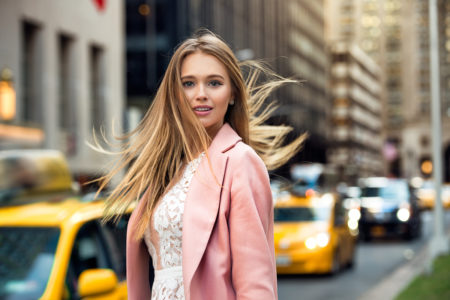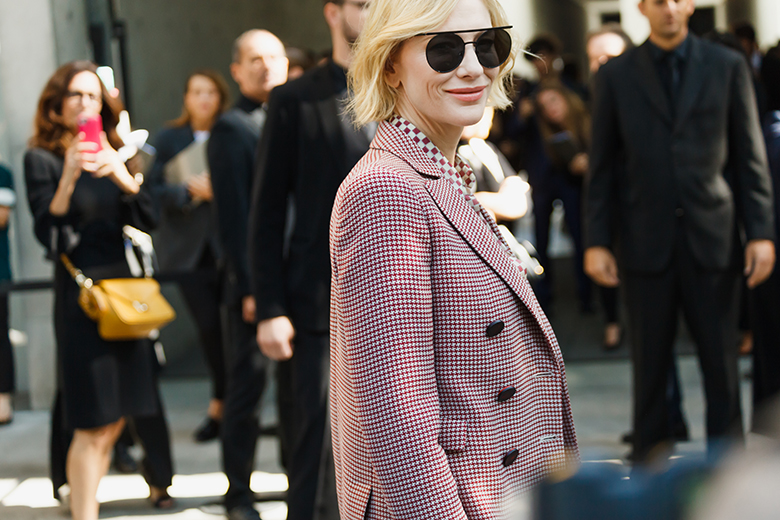
Colour matching is not a science, but people often get it wrong. Picking the best colours for your complexion is important, just like navy pairs perfectly with brown, every skin tone has their own set of colours they look best with – and ones they don’t.
We’ve created this guide for you to learn more about the colours that will suit you, so you’ll always know how to look your best.
Adding colour for your complexion to your wardrobe
Colour has an incredible ability to change or enhance the mood of not only the wearer, but of those around them.
But, as we all know, there isn’t just one shade of red. Women are typically more in-tune with their ‘colour profile’ because of hours spent finding the right shade of foundation or right shade of red lipstick for their complexion. There are dusty reds, maroons, wine-reds, true reds, pinky-reds, orangey-reds… and just as a blue undertone separates the colour from true red, so too does our undertone or level of contrast dictate what type of red looks best on us.
Colour theory should never be about what colours you can and can’t wear – it’s more about selecting the shade that will best flatter your colouring. Fashion rules are mere guidelines, so you don’t have to worry about carrying swatches of your best colours along to the shops! This guide provides suggestions which are not set in stone – while wearing colours for your complexion is always handy, style is a form of self-expression. Remember, the best way to look good in anything is to choose something you feel comfortable in.
How to find the right colours for your complexion
There are a couple of ways to find which clothes work for your colouring.
1. Contrast

The easiest way to look at the relationship between colour and skin tone is to look at the natural contrast in your face.
High contrast
Those with high contrast colouring typically have very dark hair (such as black or dark brown) with very pale skin. And, if you tan, there’s still a noticeable shift between the colour of your skin and the colour of your hair. People with this kind of complexion typically have very deep brown eyes or clear blue eyes.
- Celebrity examples: Patrick Dempsey, Jon Hamm, and Keanu Reeves.
- What to consider: Instead of balancing the high contrast of your features, the aim is to play it up. Pair rich navy tailoring with a stark white button-up. Or, for a more casual look, use a basic white tee as your base. By maintaining the high contrast across your ensemble, you’ll avoid looking drab.
- Tip: High contrasts are typically more cool-toned inclined, so stay away from your off-whites and creams. Crisp white will look smarter and won’t wash you out!
Medium contrast
You may have dark hair, but you lack the pale complexion that your high contrast counterparts have. Or you’re tanned, but your hair is still darker than your skin tone. People with this kind of complexion are more neutral-toned and can wear a multitude of shades without looking garish. Redheads can also identify with this category, as long as the contrast between their vibrant hair and fair skin is distinct. Most Asian and South American ethnicities fall into this category as well.
- Celebrity examples: Orlando Bloom, David Beckham, and Zayn Malik.
- What to consider: Instead of reaching for harsh colour pairings, opt for more neutral bases and then add a warm version of your favourite colour such as a pine green or a warm blue to keep it interesting. When donning bright colours for your complexion, such as a bright red, add it in through your tie or pocket square, alongside a muted blue button-up and navy suit.
- Tip: Stay away from clear colours such as icy blues and stark white. Opt for a warmer alternative to bring out the warmth in your complexion.
Low contrast
Low contrast refers to the lack of differentiation between one’s hair and skin colour. So, those who have tanned skin and light brown/dark blond hair, or those with dark skin and dark hair. You’ll be able to tell if you have low contrast if your usual concern when buying clothes is that certain colours wash you out. This also applies to pale Scandinavian complexions, most redheads, and those with grey hair or none at all.
- Celebrity examples: Owen Wilson, Mahershala Ali, and Ed Sheeran.
- What to consider: Muted hues such as light blues and greys work particularly well on those on the lighter side of the spectrum, whereas those with a richer skin tone will find it easier to experiment with bold colours for your complexion. Every colour you wear should help create a contrast that lacks in your complexion.
- Tip: Stay away from flesh-toned or pastel colours. The lack of depth in these hues will wash you out, so pick a more vibrant or deeper shade to create that much needed contrast. Also be careful with wearing black tops, as it can often be too heavy to carry on a regular basis. Instead, opt for black jeans or pants instead of black tops.
2. Skin tone

To define your skin colour easily, take a look at your forearm. Undertone is the hue underneath the surface and determines your skin type.
Fair and light skin
If you consider yourself to have fair or light skin (cold/blue undertone), you will most likely fit into a few other categories as well. Your hair is an intense colour, either very blonde, very dark, or red. The sun is not a friend, and you’re burnt more often than tanned. You will probably have light coloured eyes as well.
When it comes to choosing what to wear for your skin colour, pick hues that clearly contrast with your skin tone, rather than ones that are too similar to it. This will bring some colour and liveliness to your complexion.
- Celebrity examples: Cate Blanchett, Jessica Chastain, Eddie Redmayne.
- Colours that look best on you: Dark brown, burgundy, grey, navy, bright and royal blue, amethyst, deep purples, lavender, lilac, sapphire, bright rose, ruby, and emerald green.
- Colours to avoid: Yellow and orange, as well as any pastel shades or soft colours as they will only wash you out.
Medium skin
Realising you have medium skin tone and differentiating whether you have a warm or cool undertone is a little difficult. You’re not quite light and not quite olive. It may help to know that hair is most likely a very neutral colour for medium skin tones – either darker, ashy blonde or brown with warmer tones. Your eyes are probably hazel, dark green or a warm brown – and might also change colour depending on what you wear.
If you think you fit this category, choose neutral colours for your complexion that fall in the middle of the colour spectrum.
- Celebrity examples: Rachel McAdams, Scarlett Johansson, Harry Styles.
- Colours that look best on you: Dusty pink, soft rose, peach, jade green, taupe, gray, off-white and blue.
- Colours to avoid: Bright red, bright yellow. Try to steer clear of any super bright or neon colours that can overwhelm.
Olive skin – Colours For Your Complexion
The undertone of your skin is warm, either yellow, golden or olive green. Under the sun, you go brown rather than red. Your hair colour might range from dark brown to dark blonde and your eyes are most likely a shade of brown.
Your skin tone suits a wider spectrum of colours compared to those with fair complexions – but you’ll look best in shades that are either a little brighter or a little darker than the middle ground, to add some contrast.
- Celebrity examples: Jessica Alba, Jessica Szohr, Enrique Iglesias.
- Colours that look best on you: Orange, red, golden yellow, amber, warm greens, blue, turquoise, moss green, magenta, purple, chocolate brown, creamy whites.
- Colours to avoid: Colder blues, soft greens and yellows – the last two are too similar to the undertone of your complexion.
Dark skin – Colours For Your Complexion
Dark skin has a brown undertone. Your hair colour commonly ranges from brown to dark brown, while your eyes can range from green to dark brown.
Colourwise, the world is your oyster. The colour of your skin is perfectly positioned to match the vast majority of hues and shades. The best part is, it doesn’t run the risk of being washed out like pale skin tones.
The safest colours to match with darker skin are white, bright or light colours – that said, your tone provides a wide array of options.
- Celebrity examples: Viola Davis, Oprah Winfrey, Jesse Williams.
- Colours that look best on you: Purple, pink, peach, orange, yellow, jade green, cobalt blue and bright colours in general.
- Colours to avoid for dark skin: Brown, navy and lots of black – these dark colours won’t contrast nearly enough with dark skin and detract from your outfit, just like people with fair skin shouldn’t wear white.
Where to start with colours for your complexion
Knowing what colours suit your skin tone can really give you an edge that will help improve your wardrobe. As a general rule, always try to steer clear of colours that are too similar to your skin tone, as they won’t really contrast well.
If you’re interested in expanding your colour horizons, be sure to go in-store and try on different shades of the same hue to see what looks best. Fashion rules are meant to be broken, so experiment.
And always bear in mind that at the end of the day, what you wear is your own choice – tied to your personal style. If we didn’t mention a colour you love for your skin tone, wear it as an accessory!
With any clothes you buy, fit is always key so make sure to visit us and we’ll have you looking your best in any colour you fancy.
Need Help Finding The Best Colours For Your Complexion
LOOKSMART’s qualified team of 178+ certified fashion stylists and consultants can help you find the best colours for you complexion.
Our High Quality Services Are Available in Australia and New Zealand
120 stores across Australia and New Zealand. Expert tailors and seamstress providing all types clothing alterations and repairs. Most stores also provide dry cleaning. Selected stores provide styling, embroidery and dressmaking, select your category within the store locator filter to view stores providing special services.
